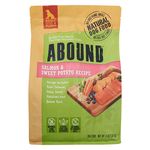
DogFoodAdvisor is reader supported See how
All reviews are 100% impartial but if you buy using links on this page, we may earn a referral fee.
Our Verdict
The Abound product line includes the 4 dry dog foods listed below.
Each recipe includes its AAFCO nutrient profile: Growth (puppy), Maintenance (adult), All Life Stages, Supplemental or Unspecified.
| Product line | Rating | AAFCO |
|---|---|---|
| Abound Lamb and Brown Rice | 2.5 | A |
| Abound Salmon and Sweet Potato | 2.5 | A |
| Abound Chicken and Brown Rice | 2.5 | A |
| Abound Superfood Blend | 3.5 | A |
Recipe and Label Analysis
Abound Lamb and Brown Rice was selected to represent the other products in the line for detailed recipe and nutrient analysis.
Abound Lamb and Brown Rice
Estimated Dry Matter Nutrient Content
Protein
Fat
CarbsCarbohydrates
Deboned lamb, oat meal, whole ground barley, turkey meal, whole ground brown rice, peas, rice bran, animal fat (preserved with mixed tocopherols), menhaden fish meal, chicken meal, flaxseed meal, natural flavor, tomato pomace (source of lycopene), potassium chloride, brewers dried yeast, dried whey, canola oil, alfalfa meal, sweet potatoes, carrots, salt, blueberries, cranberries, barley grass, dried parsley, Yucca schidigera extract, l-carnitine, l-lysine, dried chicory root, beta carotene, calcium carbonate, dicalcium phosphate, choline chloride, ferrous sulfate, zinc oxide, dl-alpha tocopherol, vitamin A supplement, manganous oxide, copper sulfate, niacin supplement, calcium pantothenate, menadione sodium bisulfite complex (source of vitamin K activity), vitamin D3 supplement, ethylenediamine dihydroiodide, riboflavin supplement, thiamine mononitrate, cobalt carbonate, pyridoxine hydrochloride, folic acid, biotin,vitamin B12 supplement, sodium selenite, iron amino acid chelate, zinc amino acid chelate, manganese amino acid chelate, copper amino acid chelate, dried Lactobacillus acidophilus fermentation product, dried Lactobacillus casei fermentation product, dried Bifidobacterium thermophilum fermentation product, dried Enterococcus faecium fermentation product
Fiber (estimated dry matter content) = 4%
Red denotes any controversial items
| Estimated Nutrient Content | |||
|---|---|---|---|
| Method | Protein | Fat | Carbs |
| Guaranteed Analysis | 22% | 13% | NA |
| Dry Matter Basis | 24% | 14% | 53% |
| Calorie Weighted Basis | 22% | 31% | 47% |
Ingredients Analysis
The first ingredient in this dog food is lamb. Although it is a quality item, raw lamb contains up to 73% water. After cooking, most of that moisture is lost, reducing the meat content to just a fraction of its original weight.
After processing, this item would probably account for a smaller part of the total content of the finished product.
The second ingredient is oatmeal, a whole-grain product made from coarsely ground oats. Oatmeal is naturally rich in B-vitamins, dietary fiber and can be (depending upon its level of purity) gluten-free.
The third ingredient is barley. Barley is a starchy carbohydrate supplying fiber and other healthy nutrients. However, aside from its energy content, this cereal grain is of only modest nutritional value to a dog.
The next ingredient is turkey meal. Turkey meal is considered a meat concentrate and contains nearly 300% more protein than fresh turkey.
The fifth inclusion is ground brown rice, another name for rice flour. Ground rice is made from either white or brown rice and is considered a gluten-free substitute for wheat flour.
The sixth ingredient includes peas. Peas are a quality source of carbohydrates. And like all legumes, they’re rich in natural fiber.
However, peas contain about 25% protein, a factor that must be considered when judging the meat content of this dog food.
The seventh ingredient is rice bran, a healthy by-product of milling whole grain rice. The bran is the fiber-rich outer layer of the grain containing starch, protein, fat as well as vitamins and minerals.
The next ingredient is animal fat. Animal fat is a generic by-product of rendering, the same high-temperature process used to make meat meals.
Since there’s no mention of a specific animal, this item could come from just about anywhere: salvaged roadkill, spoiled supermarket meat… even dead, diseased or dying cattle.
For this reason, we do not consider generic animal fat a quality ingredient.
The ninth ingredient is menhaden fish meal, another protein-rich meat concentrate.
Menhaden are small ocean fish related to herring. They’re rich in protein and omega-3 fatty acids. What’s more, in their mid-depth habitat, menhaden are not exposed to mercury contamination as can be typical with deep water species.
This item is typically obtained from the “clean, dried, ground tissue of undecomposed whole fish and fish cuttings” of commercial fish operations.1
The next item includes chicken meal, yet another high protein meat concentrate.
From here, the list goes on to include a number of other items.
But to be realistic, ingredients located this far down the list (other than nutritional supplements) are not likely to affect the overall rating of this Abound product.
With 8 notable exceptions…
First, flaxseed meal is one of the best plant-based sources of healthy omega-3 fatty acids. Flax meal is particularly rich in soluble fiber.
However, flaxseed contains about 19% protein, a factor that must be considered when judging the actual meat content of this dog food.
Next, tomato pomace is a controversial ingredient, a by-product remaining after processing tomatoes into juice, soup and ketchup.
Many praise tomato pomace for its high fiber and nutrient content, while others scorn it as an inexpensive pet food filler.
Just the same, there’s probably not enough tomato pomace here to make much of a difference.
In addition, brewers yeast can be a controversial item. Although it’s a by-product of the beer making process, this ingredient is rich in minerals and other healthy nutrients.
Fans believe yeast repels fleas and supports the immune system.
Critics argue yeast ingredients can be linked to allergies. This may be true, but (like all allergies) only if your particular dog is allergic to the yeast itself.
In addition, a vocal minority insists yeast can increase the risk of developing the life-threatening condition known as bloat. However, this is a claim we’ve not been able to scientifically verify.
In any case, unless your dog is specifically allergic to it, yeast can still be considered a nutritious additive.
What’s more noteworthy here is that brewers yeast contains about 48% protein, a factor that must be considered when judging the actual meat content of this dog food.
Next, this recipe contains canola oil. Unfortunately, canola can be a controversial item. That’s because it can sometimes (but not always) be derived from genetically modified rapeseed.
Yet others cite the fact that canola oil can be a significant source of essential omega-3 fatty acids.
In any case, plant-based oils like canola are less biologically available to a dog than fish oil as a source of quality omega-3 fats.
We also find alfalfa meal in this recipe. Although alfalfa meal is high in plant protein (about 18%) and fiber (25%), this hay-family item is more commonly associated with horse feeds.
In addition, chicory root is rich in inulin, a starch-like compound made up of repeating units of carbohydrates and found in certain roots and tubers.
Not only is inulin a natural source of soluble dietary fiber, it’s also a prebiotic used to promote the growth of healthy bacteria in a dog’s digestive tract.
This food also contains menadione, a controversial form of vitamin K linked to liver toxicity, allergies and the abnormal break-down of red blood cells.
Since vitamin K isn’t required by AAFCO in either of its dog food nutrient profiles, we question the use of this substance in any canine formulation.
And lastly, this food includes chelated minerals, minerals that have been chemically attached to protein. This makes them easier to absorb. Chelated minerals are usually found in better dog foods.
Nutrient Analysis
Based on its ingredients alone, Abound Dog Food looks like an average dry product.
The dashboard displays a dry matter protein reading of 24%, a fat level of 14% and estimated carbohydrates of about 53%.
As a group, the brand features an average protein content of 26% and a mean fat level of 16%. Together, these figures suggest a carbohydrate content of 50% for the overall product line.
And a fat-to-protein ratio of about 61%.
Near-average protein. Near-average fat. And near-average carbs when compared to a typical dry dog food.
When you consider the protein-boosting effect of the peas, flaxseed, alfalfa meal and brewers yeast, this looks like the profile of a kibble containing a moderate amount of meat.
Abound Dog Food Recall History
The following automated list (if present) includes all dog food recalls related to Abound through April 2025.
You can view a complete list of all dog food recalls since 2009 here.
Our Rating of Abound Dog Food
Abound is a grain-inclusive dry dog food using a moderate amount of named meat meals as its dominant source of animal protein, thus earning the brand 2.5 stars.
Compare Abound Dog Food
How does Abound compare with The Dog Food Advisor's most recommended brands?
A Final Word
The Dog Food Advisor does not accept money, gifts, samples or other incentives in exchange for special consideration in preparing our reviews.
However, we do receive a referral fee from online retailers (like Chewy or Amazon) and from sellers of perishable pet food when readers click over to their websites from ours. This helps cover the cost of operation of our free blog. Thanks for your support.
For more information, please visit our Disclaimer and Disclosure page.









